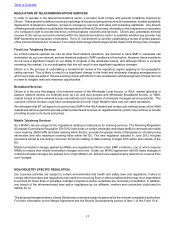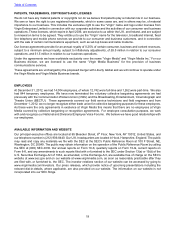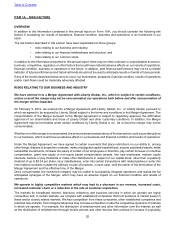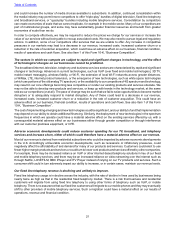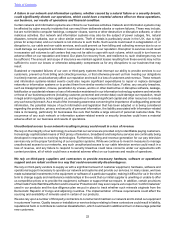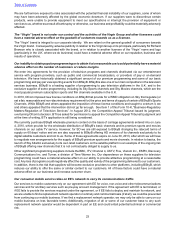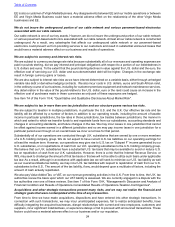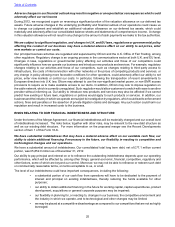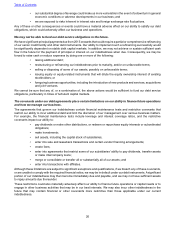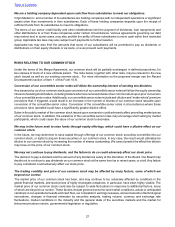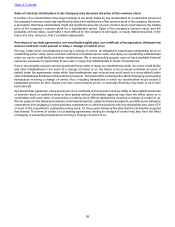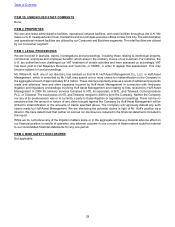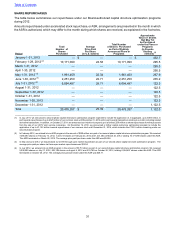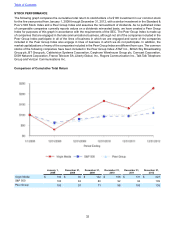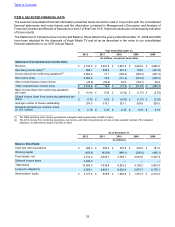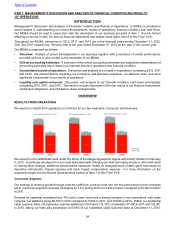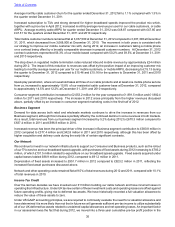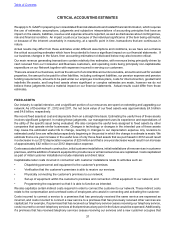Virgin Media 2012 Annual Report Download - page 28
Download and view the complete annual report
Please find page 28 of the 2012 Virgin Media annual report below. You can navigate through the pages in the report by either clicking on the pages listed below, or by using the keyword search tool below to find specific information within the annual report.
27
We are a holding company dependent upon cash flow from subsidiaries to meet our obligations.
Virgin Media Inc. and a number of its subsidiaries are holding companies with no independent operations or significant
assets other than investments in their subsidiaries. Each of these holding companies depends upon the receipt of
sufficient funds from its subsidiaries to meet its obligations.
The terms of our senior credit facility and other indebtedness limit the payment of dividends, loan repayments and
other distributions to or from these companies under certain circumstances. Various agreements governing our debt
may restrict and, in some cases, may also prohibit the ability of these subsidiaries to move cash within their restricted
group. Applicable tax laws may also subject such payments to further taxation.
Applicable law may also limit the amounts that some of our subsidiaries will be permitted to pay as dividends or
distributions on their equity interests or as loans, or even prevent such payments.
RISKS RELATING TO OUR COMMON STOCK
Under the terms of the Merger Agreement, our common stock will be partially exchanged, in defined proportions, for
two classes of stock of a new ultimate parent. The risks below, together with other risks, may be relevant to the new
stock issued as well as our existing common stock. For more information on the proposed merger see the Recent
Developments section of Item 1 of this Form 10-K.
Conversion of our convertible senior notes will dilute the ownership interest of existing stockholders.
Any issuance by us of our common stock upon conversion of our convertible senior notes will dilute the equity ownership
interest of existing stockholders, including holders who have received shares of our common stock upon prior conversion
of our convertible senior notes. Additionally, our convertible senior notes include anti-dilution and “make-whole” premium
provisions that, if triggered, would result in an increase in the number of shares of our common stock issuable upon
conversion of the convertible senior notes. Conversion of the convertible senior notes in circumstances where these
provisions have operated could have a significantly greater dilutive effect.
Sales in the public market of the common stock issued upon conversion could adversely affect prevailing market prices
of our common stock. In addition, the existence of the convertible senior notes may encourage short selling by market
participants, which could cause the value of our common stock to decrease.
We may in the future seek to raise funds through equity offerings, which could have a dilutive effect on our
common stock.
In the future, we may determine to raise capital through offerings of our common stock, securities convertible into our
common stock, or rights to acquire these securities or our common stock. In any case, the result would ultimately be
dilutive to our common stock by increasing the number of shares outstanding. We cannot predict the effect this dilution
may have on the price of our common stock.
We may not continue to pay dividends, and the failure to do so could adversely affect our stock price.
The decision to pay a dividend and the amount of any dividend is solely at the discretion of the Board. Our Board may
decide not to continue to pay dividends on our common stock at the same level as in recent years, or at all. Any failure
to pay a dividend could adversely affect our stock price.
The trading volatility and price of our common stock may be affected by many factors, some of which are
beyond our control.
The market price of our common stock has been, and may continue to be, adversely affected by conditions in the
global financial markets, and stock prices of highly leveraged companies, in particular, have been highly volatile. The
market price of our common stock could also be subject to wide fluctuations in response to additional factors, many
of which are beyond our control. These factors include general economic and market conditions, actual or anticipated
variations in our operational results and cash flow, our competitors' earnings releases, announcements of technological
innovations, changes in financial estimates by securities analysts, trading volume, currency and exchange rate
fluctuations, market conditions in the industry and the general state of the securities markets and the market for
telecommunications stocks, governmental legislation or regulation.
Table of Contents


